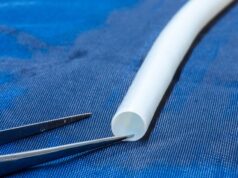
At two years, mechanochemical ablation (MOCA) is as efficacious as current endothermal techniques without the need of tumescent anaesthesia and is more effective than reported results of foam sclerotherapy of the great saphenous vein. Steve Elias, who presented the first-in-man two-year results with the technique at the Vascular Annual Meeting (Washington DC, USA,7–9 June 2012), said that MOCA is another alternative modality for most incompetent great and small saphenous veins.
Elias, director, Division of Vascular Surgery Vein Programs, Columbia University and Medical Center, New York, USA, told delegates that the mechanochemical ablation catheter (ClariVein, Vascular Insights) utilises a liquid sclerosant (sodium tetradecyl sulfate or aethoxysclerol) and a mechanical rotating wire to accomplish occlusion of incompetent great or small saphenous vein. The procedure does not require tumescence and is performed with local anaesthesia at the access site only. It can be characterised as mechanically enhanced sclerotherapy performed in an office setting.
Thirty great saphenous veins in 29 patients underwent micropuncture access with local anaesthesia only in this first-in-man study. Through a 5F micropuncture sheath the MOCA catheter was passed to a position 2cm from the saphenofemoral junction. Catheter wire rotation was begun for 3 seconds at 3,500rpm. With the wire rotating, infusion of sclerosant (1.5% sodium tetradecyl sulfate) and catheter pullback (1.5mm/sec) was begun simultaneously. A total of 12cc of sclerosant was used for each great saphenous vein. The procedure does not require the instillation of tumescent aneasthesia.
At one year, 29 of 30 great saphenous veins were successfully treated. Primary closure rate 96%. At two years, 24 patients were examined. All 24 remain closed. No deep vein thrombosis, nerve or skin injury occurred. Average total procedure time was 14 minutes. Catheter treatment time was five minutes. The MOCA technique has been modified; lower volumes are now used based on diameter and length of vein treated. Catheter placement is closer to saphenofemoral junction (1cm).
Elias said that 6,000 cases have been treated with MOCA worldwide, with >90% occlusion rate. Quality of life was improved as with any successful endovenous ablation intervention. Deep vein thrombosis rate was below 1% and there was no nerve/skin injury. Elias also told delegates what we have learned about the technique: “Rotate first (spasm/vortex) then inject slow. Catheter on is catheter moving. It is a two-handed technique, one pulls and one injects.
The tendency is to pull too fast and to inject too slow.” About volume, he said, that it originally was 12cc (1.5% STD) for all. Now, he added, volume is based on diameter/length and tends to be less. On concentration, he said that stronger is better.
Elias summarised his presentation saying that MOCA works and is safe, with a learning curve of five to eight cases. It does not involve the use of tumescence anaesthesia and is another good option for ablation.












